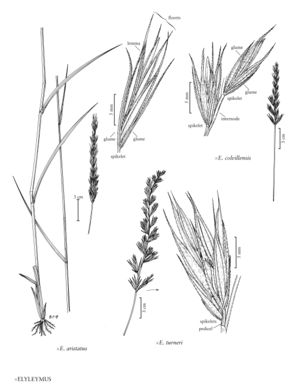Difference between revisions of "×elyleymus aristatus"
FNA>Volume Importer |
FNA>Volume Importer |
||
| Line 6: | Line 6: | ||
|synonyms={{Treatment/ID/Synonym | |synonyms={{Treatment/ID/Synonym | ||
|name=Elymus aristatus | |name=Elymus aristatus | ||
| − | |authority= | + | |authority= |
| + | |rank=species | ||
}} | }} | ||
|hierarchy=Poaceae;Poaceae subfam. Pooideae;Poaceae tribe Triticeae;×elyleymus;×elyleymus aristatus | |hierarchy=Poaceae;Poaceae subfam. Pooideae;Poaceae tribe Triticeae;×elyleymus;×elyleymus aristatus | ||
| Line 19: | Line 20: | ||
-->{{Treatment/Body | -->{{Treatment/Body | ||
|distribution=Colo.;Wash.;Calif.;Oreg.;Wyo.;Idaho;Nev. | |distribution=Colo.;Wash.;Calif.;Oreg.;Wyo.;Idaho;Nev. | ||
| − | |discussion=<p>Dewey and Holmgren (1962) argued that ×Elyleymus aristatus comprises hybrids between Elymus elymoides and Leymus cinereus or L. triticoides. It has been found at many locations where the parents are sympatric.</p> | + | |discussion=<p>Dewey and Holmgren (1962) argued that ×Elyleymus aristatus comprises hybrids between <i>Elymus elymoides</i> and <i>Leymus cinereus</i> or <i>L. triticoides</i>. It has been found at many locations where the parents are sympatric.</p> |
|tables= | |tables= | ||
|references= | |references= | ||
| Line 28: | Line 29: | ||
-->{{#Taxon: | -->{{#Taxon: | ||
name=×elyleymus aristatus | name=×elyleymus aristatus | ||
| − | |||
|authority=(Merr.) Barkworth & D.R. Dewey | |authority=(Merr.) Barkworth & D.R. Dewey | ||
|rank=species | |rank=species | ||
| Line 36: | Line 36: | ||
|family=Poaceae | |family=Poaceae | ||
|illustrator=Bee F. Gunn | |illustrator=Bee F. Gunn | ||
| + | |illustration copyright=Utah State University | ||
|distribution=Colo.;Wash.;Calif.;Oreg.;Wyo.;Idaho;Nev. | |distribution=Colo.;Wash.;Calif.;Oreg.;Wyo.;Idaho;Nev. | ||
|reference=None | |reference=None | ||
| Line 41: | Line 42: | ||
|publication year= | |publication year= | ||
|special status= | |special status= | ||
| − | |source xml=https:// | + | |source xml=https://jpend@bitbucket.org/aafc-mbb/fna-data-curation.git/src/f50eec43f223ca0e34566be0b046453a0960e173/coarse_grained_fna_xml/V24/V24_490.xml |
|subfamily=Poaceae subfam. Pooideae | |subfamily=Poaceae subfam. Pooideae | ||
|tribe=Poaceae tribe Triticeae | |tribe=Poaceae tribe Triticeae | ||
Revision as of 20:21, 16 December 2019
Plants not or shortly rhizomatous. Culms 60-130 cm, glabrous. Leaves evenly distributed on the culms; sheaths smooth, glabrous; auricles poorly developed, to 0.5 mm; ligules 1-2.5 mm, scarious, rounded; blades about 5.5 mm wide, abaxial surfaces glabrous, mostly smooth, scabrous near the margins, adaxial surfaces scabridulous, primary veins separated by about 3 secondary veins. Inflorescences spikes, 6-15 cm long, 10-15 mm wide including the awns, 7-10 mm wide excluding the awns, erect, with 2-3 sessile or subsessile spikelets per node; internodes 4-7 mm, concealed by the spikelets; disarticulation tardy, in the rachises and beneath the florets. Spikelets 10-20 mm excluding the awns, to 18 mm including the awns, with 3-4 florets. Glumes 8-15 mm long, 0.3-0.5 mm wide, subequal to unequal, scabrous; lemmas 7.5-12 mm, glabrous, smooth or scabrous, sometimes only scabrous distally, midveins prominent and scabrous distally, awns 4-5 mm; anthers 2.2-2.4 mm.
Distribution
Colo., Wash., Calif., Oreg., Wyo., Idaho, Nev.
Discussion
Dewey and Holmgren (1962) argued that ×Elyleymus aristatus comprises hybrids between Elymus elymoides and Leymus cinereus or L. triticoides. It has been found at many locations where the parents are sympatric.
Selected References
None.
